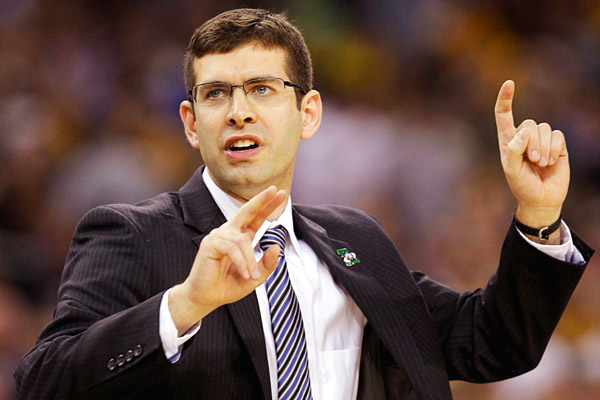Can The New and Improved Atlantic 10 Eclipse the Crumbling Big East?
Posted by Chris Johnson on October 3rd, 2012Chris Johnson is an RTC Columnist. He can be reached @ChrisDJohnsonn.
Scores of columns, blog posts and features have focused on the imminent decline of Big East basketball. The central themes – conference realignment, fooball-motivated injustices, the evils of media rights contracts destroying competitive purity – are for the most part identical. It’s basically the same ideas recreated and refined across different platforms and outlets. And we’ve only reached the tip of the iceberg. Starting in 2013-14, when Syracuse and Pittsburgh (and possibly Notre Dame) head off to the ACC, the defeatist Big East literature will resurface in greater frequency. Like many fellow college basketball scribes, I believe the Big East will lose some of its competitive intrigue once conference realignment commitments fall into place. But I do not abide by the notion that conference realignment is a unilateral force destroying college basketball, or that all realignment-related decisions by definition neglect the happenings on the hardwood and/or affect negative change to the sport’s league structure. Case in point: the Atlantic 10. Thanks to the addition of two emerging programs by way of realignment (Butler and VCU), the A-10, despite also losing Temple and Charlotte, has positioned itself to stake its claim as one of the top three or four basketball leagues in the country.

Adding Butler to the fray gives the A-10 another perennial Tournament contender (Photo credit: David J. Phillip/AP Photo).
The positive outlook in A-10 country is not lost on college hoops TV rights negotiators. They proved as much on Tuesday, when broadcast giants ESPN, CBS and NBC committed to the league long-term by securing eight year partnerships, which, according to the conference’s official release, will “give the league unprecedented reach, distribution and marketing, allowing the Atlantic 10 to better serve its fans in its extensive media footprint and to leverage the promotional platforms and marketing assets of these three major media companies.” With the league’s undeniably positive trajectory, this move was an eventuality, a no-brainer proposition for media companies seeking to leverage an untapped source of national viewings gold. There’s little doubt the A-10 has reached power conference-level status, even if it’s not regarded as such. Bolstered by the otherwise gloomy optics of conference realignment, the league is primed to cement its footprint among the sport’s elite. It has a potent mix of thriving programs capable of challenging and stealing NCAA Tournament bids from high-majors; now the broadcast and financial baselines are locked in. The A-10 is, in short, booming. But does it have the staying power to upstage the withering Big East?
Defection – and the league-altering implications that defection entails – from the Big East is not an overnight phenomenon. The process began in the mid-2000s, when Miami, Virginia Tech and Boston College jumped to the ACC, followed by Temple’s move to the A-10. The Big East reloaded with a handful of Conference USA schools (Cincinnati, DePaul, Louisville, Marquette and South Florida), most of which have elevated the league’s stature and prestige. While slightly out of geographic sync with the league’s traditionally northeastern focus, the C-USA newcomers were positive pickups. It was the latest wave of realignment, which sent off West Virginia, Syracuse, Pittsburgh and Notre Dame, that took a large chunk out of the league’s historical and competitive appeal. Unlike its C-USA replacement strategy, the Big East’s frenzied nationwide search-and-invite mission netted a discordant ensemble of mostly lackluster programs. Memphis and Temple are nice additions, but the rest (San Diego State in football, UCF, SMU) weren’t nearly as promising. The Big East isn’t going anywhere, not with Cincinnati, Louisville, Georgetown, Villanova and Marquette competing at the sport’s highest levels, and Memphis and Temple bringing their own unique brands of hoops prowess to the mix; but there’s no question the league is taking a step back, from both a competitive and reputation standpoint.
It’s fitting that the same mechanism propelling the Big East’s negative momentum, conference realignment, has provided the A-10 with arguably the strongest and most talented mix of programs in its history. In the short run, this league will be a regional and national force. But college basketball – as is the case with most other sports – is cyclical, and that up-and-down programmatic flow could be the countervailing force that preserves the Big East’s relative superiority over the A-10. Doubtful though it may seem, it’s not at all unfathomable to think the A-10 could soon recede among the indeterminate national mid-major pack. At this point, after years of NCAA Tournament success, of outgunning its fellow non-BCS peers, that’s an unlikely outcome. The A-10 has enough tradition and stability to remain a nationally-relevant hoops entity. But it may not have the top-to-bottom depth to hang with the high-majors for any extended context. The Big East, for all its recent departures, is still a talented league. It’s not the old Big East, the fabled land of Boeheim and Dixon and Calhoun, but it’s still a top-tier conference. The A-10 is brimming with optimism, and it’s hard to condemn that rosy viewpoint – major media rights power brokers apparently share that sentiment. But I’m loath to grant the league competitive standing over one of the sport’s historic juggernauts. The Big East is riding a foreboding trough, with most indications pointing toward a future existence beneath the A-10’s growing virtue. But it still has the historical and structural fortitude to hold off the ascendant league. The Big East can still outlast the A-10 on name-brand recognition, or at least preserve an equal distinctive footing. Whether it’s able to do that over the long run is an open question.












































